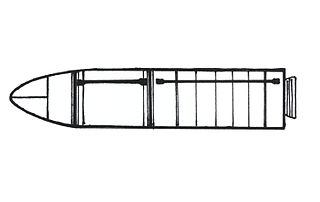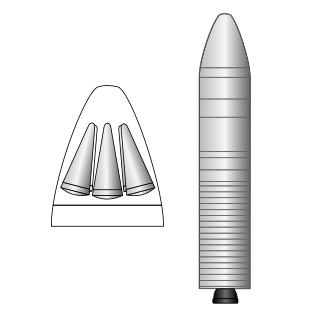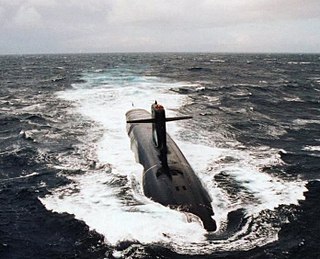
A ballistic missile uses projectile motion to deliver warheads on a target. These weapons are guided only during relatively brief periods—most of the flight is unpowered. Short-range ballistic missiles stay within the Earth's atmosphere, while intercontinental ballistic missiles (ICBMs) are launched on a sub-orbital flight.

A submarine-launched ballistic missile (SLBM) is a ballistic missile capable of being launched from submarines. Modern variants usually deliver multiple independently targetable reentry vehicles (MIRVs), each of which carries a nuclear warhead and allows a single launched missile to strike several targets. Submarine-launched ballistic missiles operate in a different way from submarine-launched cruise missiles.

The Diamant rocket was the first exclusively French expendable launch system and at the same time the first satellite launcher not built by either the United States or USSR. As such, it has been referred to as being a key predecessor for all subsequent European launcher projects.

A ballistic missile submarine is a submarine capable of deploying submarine-launched ballistic missiles (SLBMs) with nuclear warheads. The United States Navy's hull classification symbols for ballistic missile submarines are SSB and SSBN – the SS denotes submarine, the B denotes ballistic missile, and the N denotes that the submarine is nuclear powered. These submarines became a major weapon system in the Cold War because of their nuclear deterrence capability. They can fire missiles thousands of kilometers from their targets, and acoustic quieting makes them difficult to detect, thus making them a survivable deterrent in the event of a first strike and a key element of the mutual assured destruction policy of nuclear deterrence.

The M4 was a French submarine-launched ballistic missile (SLBM) deployed on the nuclear Redoutable-class submarines.

The M45 SLBM was a French Navy submarine-launched ballistic missile Forty-eight M45 were in commission in the Force océanique stratégique, the submarine nuclear deterrent component of the French Navy. The missiles, derived from the M4, were produced by Aérospatiale. Initially, an ICBM land-based version was considered, but these plans were discarded in 1996 to favour an all-naval deployment.

The Le Redoutable-class submarine was a ballistic missile submarine class of the French Navy. In French, the type is called Sous-marin Nucléaire Lanceur d'Engins (SNLE), literally "Missile-launching nuclear submarine". When commissioned, they constituted the strategic part of the naval component of the French nuclear triad, then called Force de frappe.

The M51 SLBM is a French submarine-launched ballistic missile, built by ArianeGroup, and deployed with the French Navy. Designed to replace the M45 SLBM, it was first deployed in 2010.

Le Redoutable was the lead boat of her class of ballistic missile submarines in the French Marine Nationale.

The Strategic Ocean Force has been the synonym of the French Submarine Forces since 1999, which the commandant commands the ensemble related to, along with the squadron of nuclear attack submarine.

The R-29RM Shtil was a liquid propellant, submarine-launched ballistic missile in use by the Russian Navy. It had the alternate Russian designations RSM-54 and GRAU index 3M27. It was designed to be launched from the Delta IV submarine, each of which is capable of carrying 16 missiles. The R-29RM could carry four 100 kiloton warheads and had a range of about 8,500 kilometres (5,300 mi). They were replaced with the newer R-29RMU2 Sineva and later with the enhanced variant R-29RMU2.1 Layner.

A nuclear triad is a three-pronged military force structure that consists of land-launched nuclear missiles, nuclear-missile-armed submarines, and strategic aircraft with nuclear bombs and missiles. Specifically, these components are land-based intercontinental ballistic missiles (ICBMs), submarine-launched ballistic missiles (SLBMs), and strategic bombers. The purpose of having this three-branched nuclear capability is to significantly reduce the possibility that an enemy could destroy all of a nation's nuclear forces in a first-strike attack. This, in turn, ensures a credible threat of a second strike, and thus increases a nation's nuclear deterrence.

The Triomphant class of ballistic missile submarines of the French Navy is the active lead boat class of four boats that entered service in 1997, 1999, 2004, and 2010. These four superseded the older Redoutable class, and they provide the ocean-based component of France's nuclear deterrent strike force, the Force de dissuasion. Their home port is Île Longue, Roadstead of Brest, Western Brittany.
The TN 71 is a French-built thermonuclear warhead which was used on submarine-launched ballistic missiles in Redoutable class ballistic missile submarines.
The TN 70 is a French-built thermonuclear warhead which was used on submarine-launched ballistic missiles in Redoutable class ballistic missile submarines.

The M20 was a French submarine-launched ballistic missile (SLBM) deployed on the nuclear Redoutable-class submarines from 1977. It was withdrawn from service by 1991.
The M2 MSBS was the second French submarine-launched ballistic missile. In French, MSBS is the abbreviation for Mer-Sol Balistique Stratégique, or Sea-Ground Strategic Ballistic Missile. It has two stages. It was deployed on the Redoutable-class SNLEs or SSBNs from 1974 to 1978, replacing the M1 MSBS. The M2 was itself replaced by the M20 MSBS beginning in 1977.
The Interarmy Special Vehicles Test Centre (CIEES) was France's first space launch and ballistic missile testing facility. Outside France, the facility is often referred to by the name of the nearest town, Hammaguir. It was established on 24 April 1947, by ministerial decree as the Special Weapons Test Center for use by the French Army. In 1948, it was turned over to the French Air Force, who renamed it CIEES. Its remote location in the middle of the Saharan Desert and its relative closeness to the Equator made it an attractive launch site for missiles and orbital rockets.












